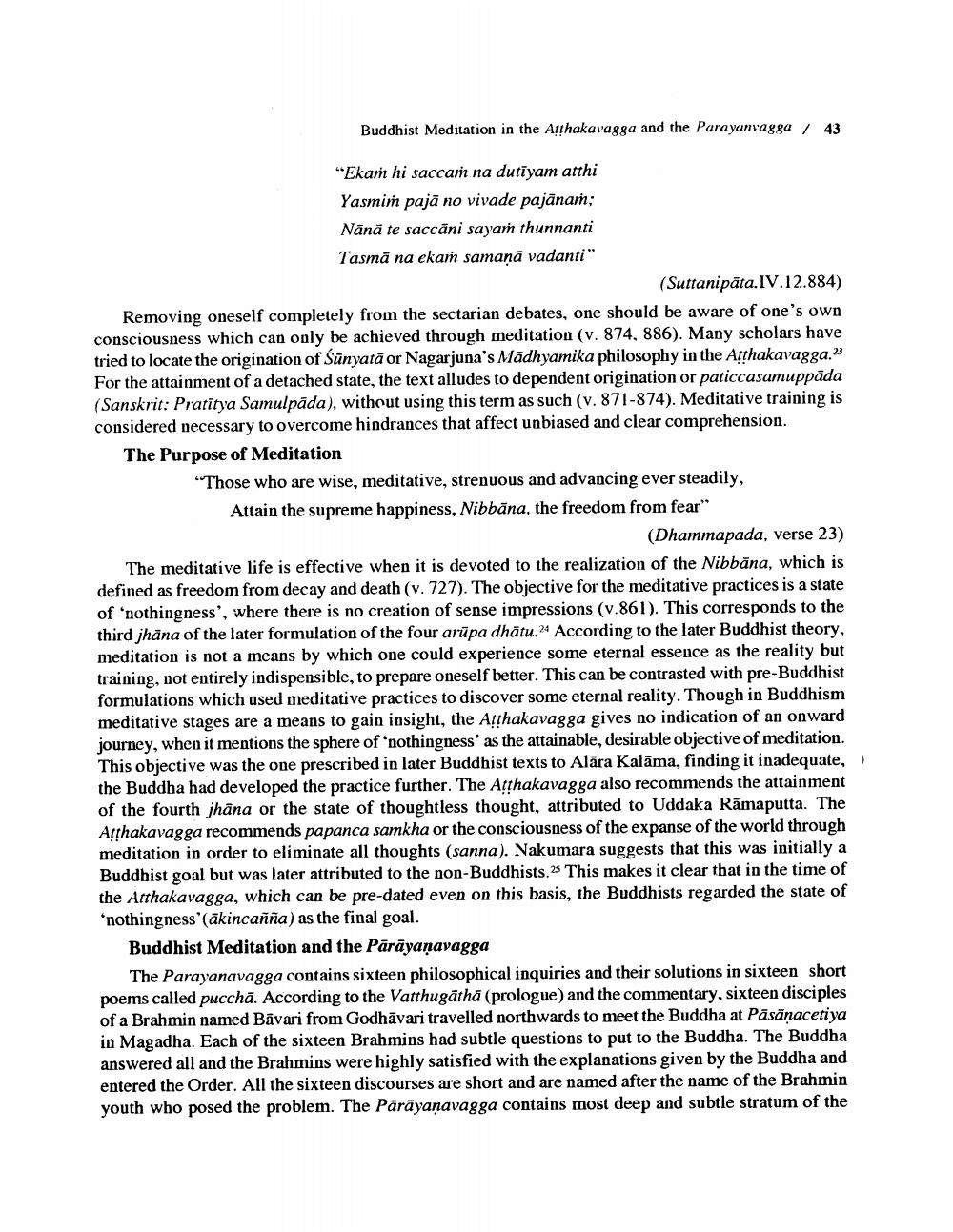________________
Buddhist Meditation in the Athakavagga and the Parayan vagga / 43
"Ekar hi sacca na dutīyam atthi Yasmim pajā no vivade pajānam; Nānā te saccăni saya thunnanti Tasmā na ekar samanā vadanti"
(Suttani pāta.IV.12.884) Removing oneself completely from the sectarian debates, one should be aware of one's own consciousness which can only be achieved through meditation (v. 874, 886). Many scholars have tried to locate the origination of Sünyatā or Nagarjuna's Mādhyamika philosophy in the Atthakavagga.23 For the attainment of a detached state, the text alludes to dependent origination or paticcasamuppāda (Sanskrit: Pratītya Samulpāda), without using this term as such (v. 871-874). Meditative training is considered necessary to overcome hindrances that affect unbiased and clear comprehension. The Purpose of Meditation
"Those who are wise, meditative, strenuous and advancing ever steadily, Attain the supreme happiness, Nibbāna, the freedom from fear"
(Dhammapada, verse 23) The meditative life is effective when it is devoted to the realization of the Nibbāna, which is defined as freedom from decay and death (v. 727). The objective for the meditative practices is a state of 'nothingness', where there is no creation of sense impressions (v.861). This corresponds to the third jhāna of the later formulation of the four arūpa dhätu.24 According to the later Buddhist theory, meditation is not a means by which one could experience some eternal essence as the reality but training, not entirely indispensible, to prepare oneself better. This can be contrasted with pre-Buddhist formulations which used meditative practices to discover some eternal reality. Though in Buddhism meditative stages are a means to gain insight, the Athakavagga gives no indication of an onward journey, when it mentions the sphere of 'nothingness' as the attainable, desirable objective of meditation. This objective was the one prescribed in later Buddhist texts to Alāra Kalāma, finding it inadequate, the Buddha had developed the practice further. The Atthakavagga also recommends the attainment of the fourth jhâna or the state of thoughtless thought, attributed to Uddaka Rāmaputta. The Afthakavagga recommends papanca samkha or the consciousness of the expanse of the world through meditation in order to eliminate all thoughts (sanna). Nakumara suggests that this was initially a Buddhist goal but was later attributed to the non-Buddhists.25 This makes it clear that in the time of the Atthakavagga, which can be pre-dated even on this basis, the Buddhists regarded the state of *nothingness (ākincañña) as the final goal.
Buddhist Meditation and the Pārāyaṇavagga
The Parayanavagga contains sixteen philosophical inquiries and their solutions in sixteen short poems called pucchā. According to the Vatthugāthā (prologue) and the commentary, sixteen disciples of a Brahmin named Bavari from Godhāvari travelled northwards to meet the Buddha at Pasānacetiya in Magadha. Each of the sixteen Brahmins had subtle questions to put to the Buddha. The Buddha answered all and the Brahmins were highly satisfied with the explanations given by the Buddha and entered the Order. All the sixteen discourses are short and are named after the name of the Brahmin youth who posed the problem. The Pārāyaṇavagga contains most deep and subtle stratum of the




